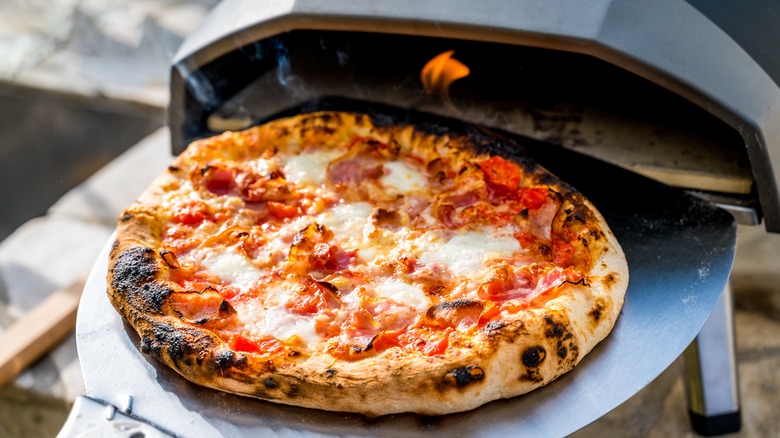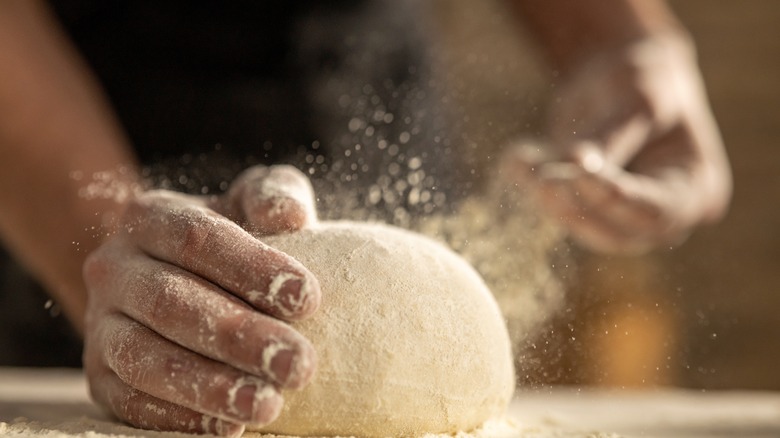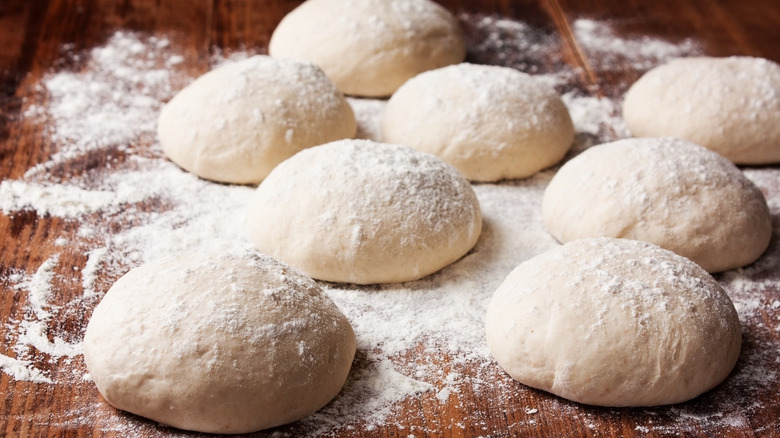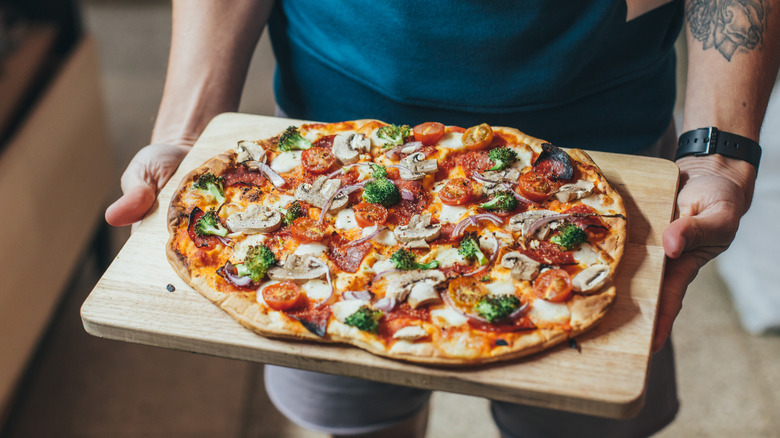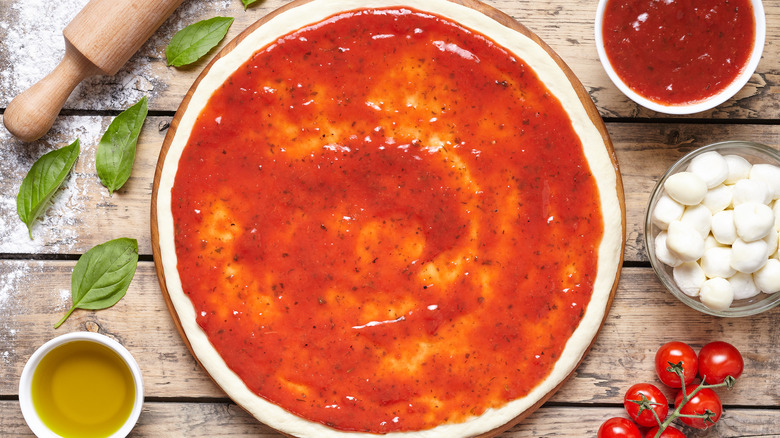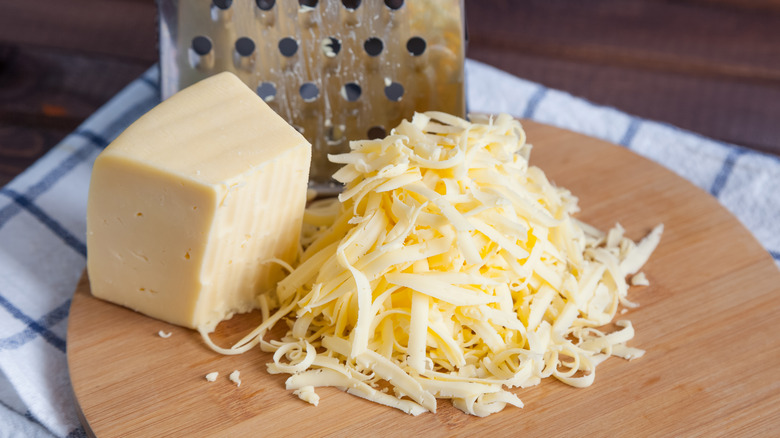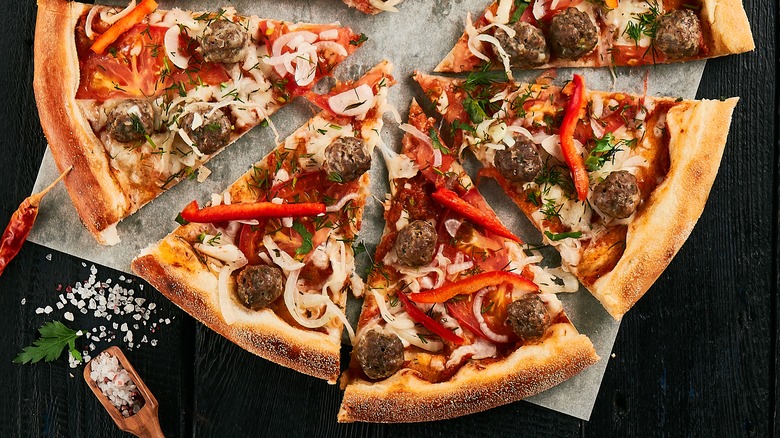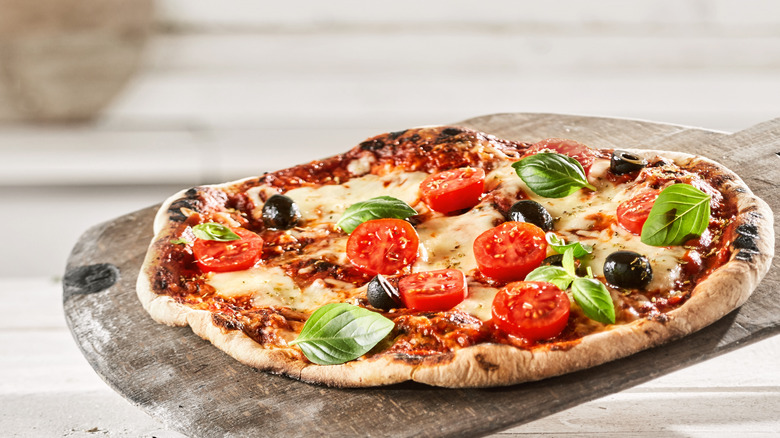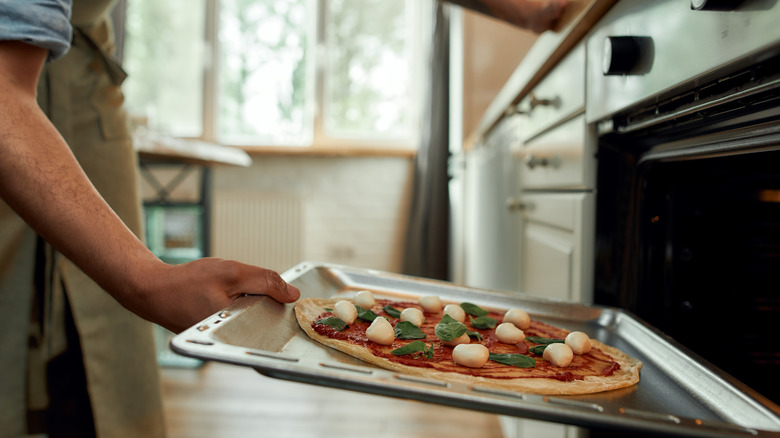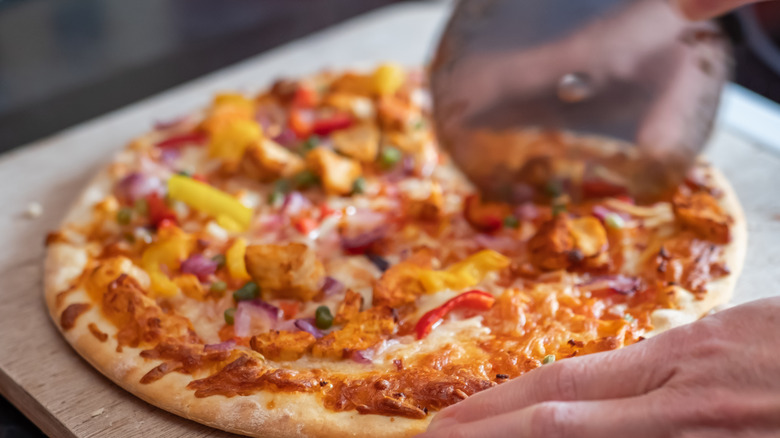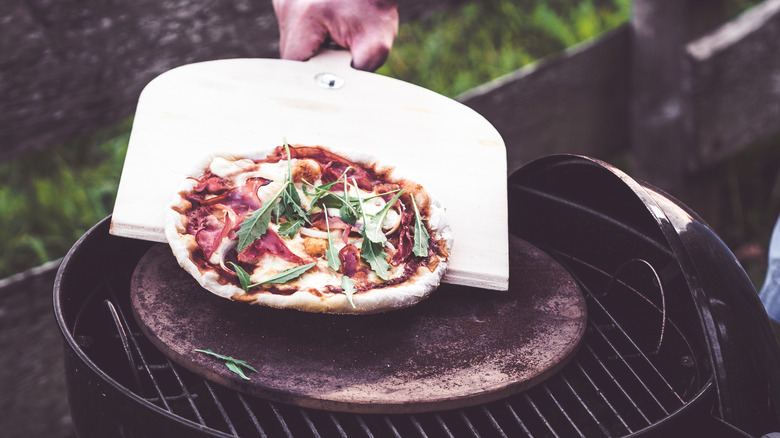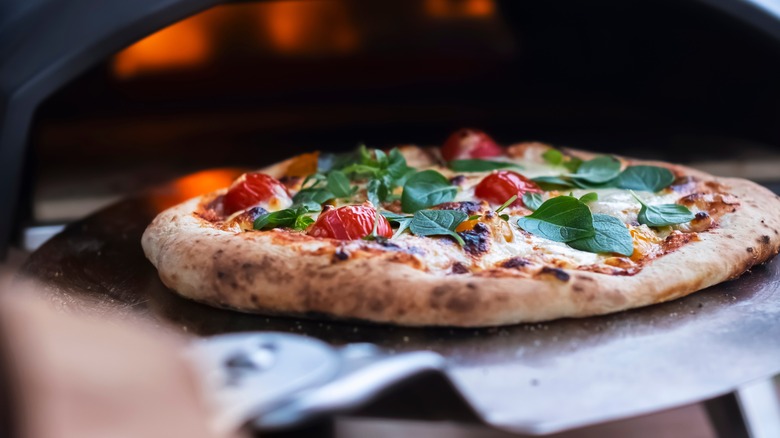11 Tips You Need For The Absolute Best Homemade Pizza
We may receive a commission on purchases made from links.
Every year 3 billion pizzas are eaten in the U.S., which breaks down to about 46 slices per person per year (via The Pizza Calc). It's always a good time for pizza. Day or night, at lunch, for dinner, or a snack.
As CNN reports, food scientists say it's an addictive food. "That combination, when heated, has enormous appeal," sensory scientist Herbert Stone told CNN. "It's addictive because there is nothing offensive about it. ... There is nothing not to like."
Whether you want a classic pepperoni and cheese pizza, or something more gourmet like breakfast pizza, you have a lot of tasty options when preparing your own pizza at home. From the right flour to dough prep to the ideal sauce and toppings, cooking tips, and cutting expertise, there's definitely an art to making the best homemade pizza. Read on for 10 tips on making the best homemade pizza.
Start with the right flour
The best pizza needs to start with the best dough. That means you can't use any old flour. Ooni recommends using quality 00 flour — doppio zero in Italian, meaning double zero flour — an Italian-style flour that's finally ground. It's the perfect ingredient for your dough because it has great flavor, provides good texture, and is very easy to make dough for thin-crust, Neapolitan-style pizza. Best of all, 00 flour helps make your pizza crispy.
You can buy 00 flour in grocery stores, online, or in Italian specialty stores. The Pizza Heaven says the best 00 flour is Caputo Pizzeria, available on Amazon, explaining it's made from high-quality wheat, is stretchy, and easy to shape. It can also handle high-heat cooking and works well in conventional and wood-fired ovens. Other 00 pizza flour options include Cento Anna Napoletana Tipo "00" Extra Fine Flour, Molino Grassi USDA Organic Italian "00" Soft Wheat Flour, and King Arthur 00 pizza flour.
Give your dough time to proof
Whatever pizza dough recipe you use, mix all your ingredients. Crust Kingdom warns against over-kneading the dough. While you want to ensure all the ingredients are mixed, you don't need to knead for more than 2 to 3 minutes.
Next, proof the dough in the fridge in a process known as cold fermentation. America's Test Kitchen explains the refrigeration process helps the gluten in the dough to relax, which makes it easier to stretch and shape later. If the dough is too firm, it might rip or snap back. The cold fermentation process also helps make the dough more flavorful.
The Test Kitchen recommends two proofs: for the first one, place a dough ball in a bowl that's lightly oiled and cover it with plastic wrap. You can refrigerate it for 1 to 3 days. For the second proof, take the dough from the first proof and shape it again into balls before returning it to the fridge for anywhere from 4 to 24 hours.
Let the dough come to room temperature for at least an hour since the warm-up will help it become more pliable for stretching. Then stretch the dough by hand, giving it great texture instead of rolling the dough, which removes the air.
Prepare your surface the right way
One of the challenges of making homemade pizza is that it sometimes doesn't cook evenly, often resulting in a soggy pizza. Set your pizza for the best outcome by cooking it on the right surface.
"It's important to spread the dough very well and very evenly," executive chef and owner at New York City's Rossopomodoro Simone Falco told Vogue. "If possible, cook the dough on a pizza stone — not on a tray." If a tray is your only choice, take Falco's advice and line the tray with parchment paper and pre-heat it in the oven for an hour.
According to Crust Kingdom, here's why a pizza stone is an ideal cooking surface for pizza: it ensures the pizza cooks evenly since it's very hot, the same way a pizza oven is. Plus, since it pulls moisture away much like a brick oven, it yields a crispy crust.
Another option is the pizza steel, a cooking surface that's made of steel and is about a quarter inch thick. It heats up fast and uses that heat to cook a crispy pizza. Blogger The Practical Kitchen says while pizza steels cost more than pizza stones, they're worth it. She's used her pizza steel hundreds of times and says it works so well because it heats up fast and is hot enough to cook like a wood oven. It's so efficient that the Practical Kitchen writes that her homemade pizzas cook in four minutes!
Choose the best sauce
What's pizza without a great sauce? Sure, you could use a store-bought sauce like Muir Glen Organic Pizza Sauce, Rao's Homemade Pizza Sauce, or Classico Traditional Pizza Sauce (via Restaurant Clicks).
Or you can make your own, like this New York-style pizza sauce featuring diced tomatoes, fresh basil, garlic, and some pantry staples, or this quick tomato sauce made with peeled plum tomatoes, garlic, olive oil, vegetable stock, and more. Try something new, like making this white sauce that boasts Parmesan cheese, all-purpose flour, milk, garlic, and a few other ingredients.
If you want homemade flavor without a lot of fuss, try this no-cook pizza sauce from Chris Bianco, owner of Pizzeria Bianco, who's featured on "Chef's Table: Pizza" on Netflix. As Bianco told Tasting Table,
"We use whole peeled organic tomatoes, our own brand. We hand crush them," he told Tasting Table. "We add a little bit of extra virgin olive oil, a little bruise of fresh basil leaves, and maybe the salt. Our tomatoes have a little bit of sea salt in them — possibly a turn of black pepper, and that's it. Leave that to sit for maybe 30 minutes before using so that basil and the olive oil have a chance to activate the tomatoes that were already in balance and delicious. Then it'll continue to reduce or cook on the pizza itself."
Select the right cheese for your pizza
Next, it's time to think about the ideal cheese for your homemade pizza. The Wisconsin Cheeseman says mozzarella is the classic cheese for topping a pizza and even has some variations, including deciding between whole milk and part-skim or fresh versus aged mozzarella. It's important to note that fresh mozzarella, which is usually placed on the pie in dollops, typically spreads out during cooking, which can result in some sogginess.
While you might want to add some Parmesan to a finished pizza, it's not recommended when baking a pizza because it's a hard cheese that's dry, meaning it won't melt. Worse yet, that great Parmesan taste you love can fade by the heat of the cooking process.
Instead, mozzarella is recommended among the best cheeses to use for pizza, as well as provolone which is good for melting; gouda if you prefer a bold taste and texture on your pizza; and burrata, which is placed in the center of the pie and oozes creaminess when the pizza is sliced.
Pick your proteins
While a traditional pizza may have marinara, basil, and cheese, proteins — specifically meat — often get all the attention on your homemade pie.
According to Pizza Planet, if you want protein or you're just a meat lover, you'll want to check out these six options: ham, which can add salt and smokiness; pepperoni, a classic topping that can be spicy; bacon, for a salty and crispy combo; sausage, which can be seasoned, ranging from mild too hot; beef, aka hamburger; and chicken, a modern topping, especially for fans of barbecue chicken.
Slice Life also suggests hot soppressata, which is a dry, Italian salami that's like pepperoni, only more flavorful; meatballs cut into slices for a yummy mix of pork and beef; prosciutto slices for an added kick of salt and pork, and a buffalo chicken which kicks things up with a bold hot wing flavor.
Want to add protein to your pizza but without meat? Blogger Lettuce Veg Out recommends vegan options like barbeque chickpeas and smoked tofu.
What to consider before adding toppings
Don't forget to season your homemade pizza. Homemade Pizza School recommends increasing flavor by adding basil, salt, pepper, oregano, and thyme.
These days there are a lot of pizza toppings to consider, from the controversial pineapple to mushrooms to olives, to peppers, and more. There are also a lot of non-traditional pizza toppings, like lamb, eggs, fruit for dessert pizza, and even edible flowers.
Still, be careful that you don't overdo it. Even too much sauce can be a bad thing. Bob's Red Mill says over-saucing your pizza can make it gooey. Homemade Pizza School cautions that too many toppings — even too much cheese — can be overwhelming for your pizza, resulting in a heavy pizza. Instead, use sauce and toppings in moderation.
Wet toppings need some extra attention, too, since they can be heavy and give your pizza a soggy bottom. Before placing them on your pie, you'll need to blot some toppings, including sun-dried tomatoes, diced pineapple, and marinated artichokes. Other toppings, such as meats like sausage or ground beef, need to be pre-cooked. It's smart to give your veggies a warm-up; fresh tomatoes, broccoli, olives, onions, and mushrooms can benefit from a quick sauté before being placed on the pizza. While the oven cooks the pizza fast, the veggies can still be firm unless pre-cooked, according to Homemade Pizza School.
What's the best temperature to cook your pizza?
Once your pie is ready to go in the oven, ensure you're baking it at the right temperature. La Cucina Italiana advises baking your pizza at the highest temperature your home oven will go, typically 480 or higher. Bake times will vary based on the recipe, but most homemade pizzas are ready within 10 to 15 minutes or less. Crust Kingdom says it's best to preheat the oven for at least 30 minutes. Ideally, you'll preheat for over an hour. Preheat your pizza pan, stone, or steel while the oven is warming up (via Bob's Red Mill).
You don't want to overcook or undercook your pizza. Crust Kingdom says if the crust is still white, don't take it out of the oven yet. During cooking, don't open the oven door, per a recommendation by Homemade Pizza School. While you may be checking on the status of your dinner, you're letting out valuable heat, which is what your pizza needs consistently during cooking. When your pizza is done, you can use the broiler setting to finish off the top, which is handy if you like a toasty top.
Lastly, even though you're eager to eat your creation, give your pizza a minute to rest. Doing so will allow the cheese to cool and settle a bit, so it won't slide off when you slice it.
Four ways to slice a pizza
When it's finally time to cut your pizza, there's no one way to slice it. Baking How says there are four ways to slice a pizza: a pizza wheel, a knife, a pizza rocker, and scissors.
The pizza wheel is the standard option. The first cut is straight down, and the next is straight across. Then slice diagonally to the desired number of slices. A pizza rocker is a large tool with a sharp angled blade used to slice pizza in a rocking back-and-forth manner. While a knife is an option for cutting slices of pizza, it's not always efficient. You can use food scissors to cut slices too.
Still, not every pizza needs to be cut into equal slices or even triangular pieces. As Homemade Pizza School explains, sometimes it's more practical to assess who's eating the pizza and how much they want. For example, a pizza with various new topping combinations may be so popular that you want to cut the pizza into smaller wedges or rectangles so many guests can try it.
Invest in the perfect peel
If you're serious about making pizza at home, invest in the right tools, especially a pizza peel — the tool with a handle (sometimes a long handle) and a surface that gets your pizza in and out of the oven. You probably know what a pizza peel is, but you may not have known it has a name. Pizza Craft explains the term derives from the French word pelle, which means shovel.
Peels are available in metal, wood, or composite materials, though wood and composite peels may be prone to moisture because they don't get as hot as metal peels, per AK Crust. That moisture could make your pizza crust become sticky. Experienced bakers do well with metal peels — which get hot fast — since those with experience move quickly, so the pizza doesn't start to cook or get stuck on the peel. Dusting it with cornmeal can help keep the pizza dough from sticking to the peel.
You might consider investing in two peels: one that's room temperature for putting the pizza in the oven and another that's hot and ready to take the pizza out of the oven (via Ooni).
Buy or build a pizza oven
Sure, you can cook pizza in your kitchen oven, but non-commercial ovens have limitations, including size and temperature, since it doesn't get as hot as a commercial pizza oven. King Arthur Baking notes restaurant pizza ovens can get up to 1000 degrees!
For that restaurant experience at home, you can build your own wood pizza oven in your backyard for $200 to $300. That's according to Crust Kingdom, explaining a DIY wood oven can be made with vermiculite, a type of volcanic rock. Other options include assembling a pre-made kit or hiring a professional mason to build a pizza oven for you.
Recently, portable outdoor ovens have gotten popular. The most notable portable oven brand is Ooni, which has been around for a decade. The pizza ovens are available in two sizes: 12-inch and 16-inch, and are either wood-fired or gas-powered. The ovens feature 900-degree heat and cook pizzas in a minute.
